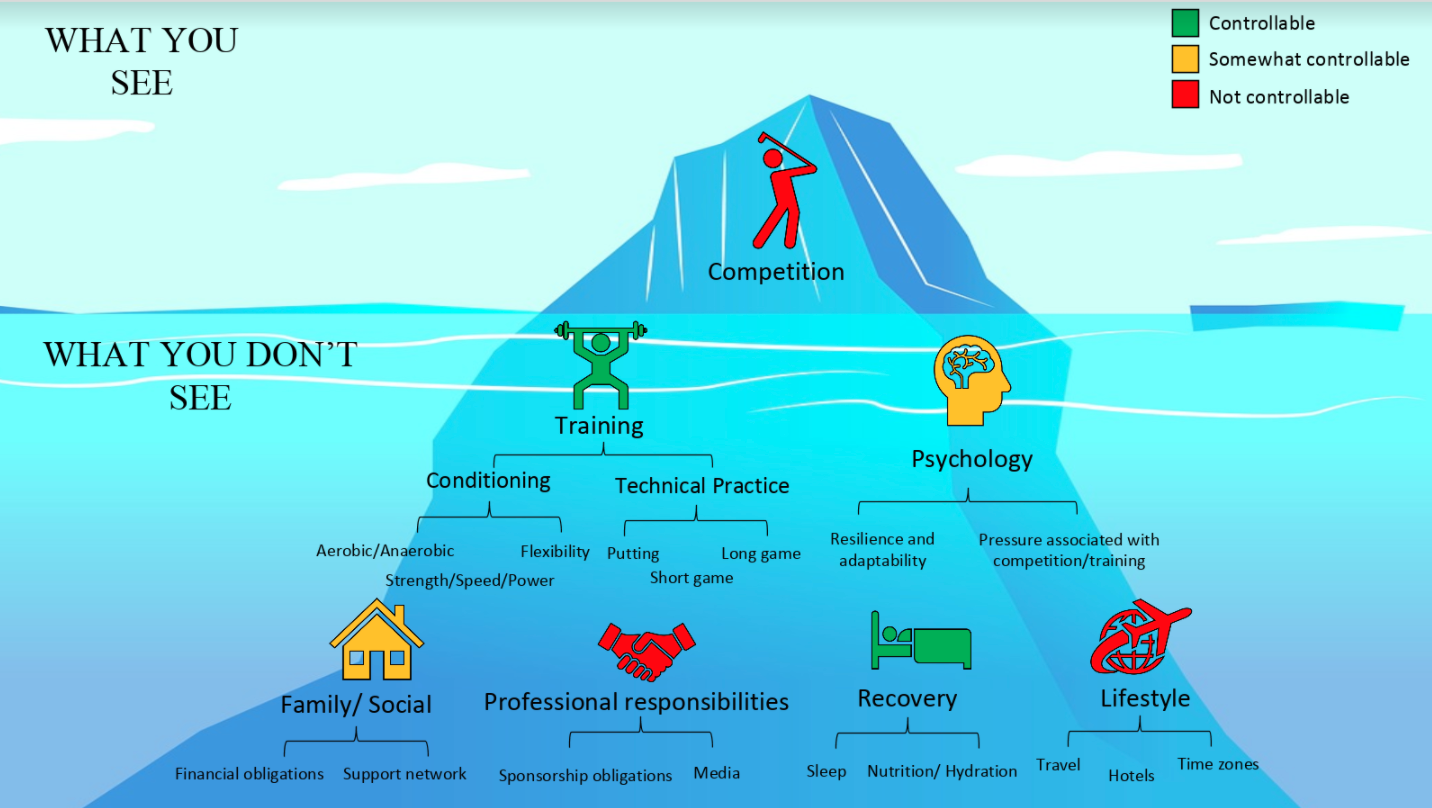In many sporting contexts, load management has become a popular topic of discussion amongst coaches, practitioners and athletes alike. Often the focus is on physical load in the form of external (work undertaken by the athlete) and internal (psychophysiological response of the athlete) load [1, 2]. Whilst the physical loads associated with performance and skill execution while playing golf may be lower than some other sports (when expressed relative to the athletes’ maximal capacity for strength, power or endurance), the psycho-sociological demands often go underestimated. Given this, to the average spectator, competition may only reflect the tip of the iceberg (Figure 1).

Figure 1. The iceberg of golfing load
Despite the growth of performance analysis and statistical approaches that underpin concepts like ‘strokes gained’, there is limited research examining load monitoring in golf. A variety of methods exist for capturing physical load, however, the need to consider sleep duration and quality, air travel, transit time and time zone changes, when developing a monitoring tool for golf specifically, have recently been highlighted [3]. Although both content validity and feasibility were demonstrated [3], the degree to which such tools are used to inform decisions about training and performance is unknown. The potential utility of wearable technology to aid this process has recently been demonstrated and may offer an insight into the future of athlete monitoring in this context, as the desire to quantify the loads on professional golfers increases [4].
The physical demands of competitive golf are characterised by long periods (typically over 5 hours) of low/moderate intensity exercise, punctuated by the high speed movements required to accelerate the golf ball to speeds exceeding 160mph[5, 6]. Successful performance is reliant upon the athlete’s ability to execute a wide range of fine motor skills within the context of very changeable environmental conditions. While the physical intensity of competition may not be high (when compared to more physiologically demanding sports), the lifestyle of a golf tour professional is distinct from many other athletes.
While golfers may exercise some control over their schedule and plan periods of rest, the time between rounds is often prescribed less than 24 hours prior. This can subsequently impact recovery and training strategies between competitive rounds but also, importantly, sleep patterns. Sleep is essential for health, wellbeing and optimal athletic performance with disrupted sleep having a harmful impact on physiological and cognitive function [7, 8].
The desire to win tournaments will motivate all golfers, however for many professional golfers the need to keep their tour status, earn a living and pay expenses can lead to significant psychological strain. Stress has been shown to negatively affect both short term and sustained performance in athletes [9]. Monitoring the response to these stressors may allow practitioners to identify periods of increased stress and ensure adequate social support structures are in place to enable the athletes ability to adapt [10].
Conclusion:
Despite the proliferation of load monitoring in professional sports, there is little evidence to demonstrate how and if load monitoring is occurring in golf and to what extent it impacts on performance and injury risk. A greater understanding of how monitoring tools (of both physical and psychological load) are currently being used would be advantageous, to ensure that future tools are ecologically valid and suitable for a golfing context.
Authors and Affiliations:
Stephen W. West- Postdoctoral Research Fellow (Sport Injury Prevention Research Centre, Faculty of Kinesiology, University of Calgary)
James Fern- Lecturer (Department for Health, University of Bath)
Laurie Canter- Professional Golfer (European Tour)
Andrew Murray- Chief Medical Officer (European Tour, European Tour Performance Institute)
References:
- Halson SL. Monitoring training load to understand fatigue in athletes. Sports Medicine 2014; 44 (2): 139-147. doi:10.1007/s40279-014-0253-z
- Impellizzeri FM, Marcora SM, Coutts AJ. Internal and External Training Load: 15 Years On. International Journal of Sports Physiology and Performance 2019. doi:10.1123/ijspp.2018-0935
- Williams SB, Gastin PB, Saw AW et al. Development of a golf-specific load monitoring tool: Content validity and feasibility. European Journal of Sport Science 2018; 18: 458-472
- Heath E. PGA Tour Players to Wear Whool Bands To Stop Covid-19 Spread. In, Golf Monthly. Online; 2020
- Luscombe J, Murray AD, Jenkins E et al. A rapid review to identify physical activity accrued while playing golf. BMJ Open 2017; 7. doi:10.1136/bmjopen-2017-018993
- Murray A, Junge A, Robinson PG et al. International consensus statement: methods for recording and reporting of epidemiological data on injury and illness in golf. British Journal of Sports Medicine 2020; Published Online First. doi:10.1136/bjsports-2020-102380
- Halson S. Sleep in elite athletes and nutritional interventions to enhance sleep. Sports Medicine 2014; 44: 13-23. doi:10.1007/s40279-014-0147-0.
- Halson S. Sleep Monitoring in Athletes: Motivation, Methods, Miscalculations and Why it Matters. Sports Medicine 2019; 49. doi:10.1007/s40279-019-01119-4
- Saw AE, Main LC, Gastin PB. Monitoring the athlete training response: subjective self-reported measures trump commonly used objective measures: a systematic review. British Journal of Sports Medicine 2016; 50: 281-291
- Andersen MB, Williams JM. A model of stress and athletic injury: Prediction and prevention. Journal of Sport and Exercise Psychology 1988; 10: 294-306